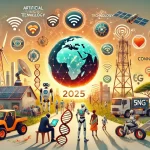In an age where seeing is no longer believing, deepfakes have emerged as both a technological marvel and a societal menace. With advanced AI tools making their creation easier than ever, deepfakes are rewriting the rules of media authenticity, fueling misinformation, and challenging our trust in what we see and hear. From viral fake images to multimillion-dollar scams, recent events underscore their growing impact, while the outlook for 2025 suggests an escalation that could reshape politics, finance, and personal lives. As we navigate this brave new world, the question looms: how do we preserve truth in an era where reality can be fabricated with a few clicks?
The Rise of Deepfakes: From Niche Tech to Global Concern
Deepfakes, named for the deep learning algorithms that power them, manipulate or replace a person’s likeness in videos, audio, or images with startling realism. What began as a niche tool for tech enthusiasts has exploded into the mainstream, thanks to accessible platforms like DeepFaceLab and mobile apps that require little expertise. By March 2025, anyone with a smartphone and a modest budget can craft a deepfake, democratizing a technology once confined to Hollywood studios and research labs.
This accessibility has a dark side. While deepfakes have legitimate uses—think CGI in films or virtual avatars—their misuse for misinformation and deception has surged. Viral AI-generated images—like the Pope in a puffer jacket in 2023 or Katy Perry at the 2024 Met Gala—have fooled millions, eroding confidence in visual media.
A Threat to Media Authenticity
At their core, deepfakes undermine media authenticity by blurring the line between real and fake. When a video of a political leader can be fabricated to say anything, or a photo can place someone where they’ve never been, the public’s ability to trust media falters. Research from early 2025 shows only 25% of people seek alternative sources when they suspect a deepfake, and just 11% critically analyze content, signaling a troubling passivity that amplifies misinformation’s reach.
The impact spans multiple domains. In politics, deepfakes could sway elections with last-minute “November surprises”—think a fake video of election fraud going viral days before polls close. While their effect on the 2024 global elections was minimal (less than 1% of fact-checked misinformation), experts warn of future risks as the technology improves. In finance, the Hong Kong scam is a harbinger of more sophisticated frauds targeting businesses and individuals. On a personal level, non-consensual deepfake images—often intimate—have become tools of harassment, causing psychological harm and reputational damage, particularly to women and public figures.
2025: A Turning Point for Deepfake Threats
As we stand in March 2025, experts predict an escalation in deepfake threats. Political interference tops the list, with fears of fabricated videos influencing elections or inciting violence. Terrorist groups could use deepfakes for recruitment or to stage fake attacks, manipulating public perception. Financial scams are expected to rise, building on the Hong Kong precedent, while criminal justice faces new challenges as deepfakes undermine evidence reliability—imagine a fake alibi video derailing a trial.
The personal toll is equally alarming. Non-consensual deepfakes, already a growing issue, could flood social media, fueling harassment and extortion. A January 2025 report identified eight key threats, from digital identity misuse (like bypassing security in Indonesia’s financial systems) to grooming schemes targeting vulnerable individuals. The technology’s sophistication may soon render deepfakes indistinguishable from reality, posing unprecedented challenges for policing and media trust.
Fighting Back: Solutions and Struggles
Combating deepfakes requires a multi-pronged approach, but solutions lag behind the technology’s rapid evolution. Education is a frontline defense: campaigns urge vigilance, citing examples like deepfake video calls tricking employees. Yet awareness alone isn’t enough—human gullibility remains a weak link, as the Hong Kong scam proved.
Technology offers hope. Tools like Mea Digital Evidence Integrity’s products aim to verify media authenticity from capture, ensuring trust in legal and journalistic contexts. Quantum-resistant defenses and AI detection systems are in development, but they’re in a constant race against ever-improving deepfake algorithms.
Legislation is catching up, albeit unevenly. By March 13, 2025, 32 U.S. states had enacted deepfake laws, targeting explicit content and political misuse, while the FTC has warned of voice cloning scams. Globally, however, regulatory gaps persist, complicating enforcement. Media literacy—teaching people to verify sources and spot red flags—remains critical, yet its adoption is slow, leaving many vulnerable to deception.
The Bigger Picture: Trust in a Synthetic Age
Deepfakes are more than a technological challenge; they’re a societal one. They exploit our trust in media, amplify misinformation, and deepen divides. The psychological toll on victims, from harassment to identity theft, is a hidden cost that 2025 is only beginning to grapple with.
The debate over deepfakes’ future is fraught with tension. Some see them as inevitable, advocating for “personality rights” to protect identities; others push for outright bans on certain uses, balancing innovation against harm. What’s clear is that 2025 will be a pivotal year. With elections looming, scams evolving, and personal privacy at stake, the stakes for media authenticity have never been higher.
Navigating the Deepfake Era
Deepfakes have transformed media from a source of truth into a battleground of perception. Recent events—the Hong Kong scam, viral fakes, and emerging threats—reveal their power to deceive and disrupt. As AI tools grow more advanced, the line between reality and fabrication will blur further, demanding action from individuals, tech innovators, and policymakers alike. In this synthetic age, preserving media authenticity isn’t just about detecting fakes—it’s about rebuilding trust in a world where anything can be engineered to deceive. The clock is ticking, and 2025 may well decide whether we master this technology or let it master us.

Posted inMedia


Truly insightful